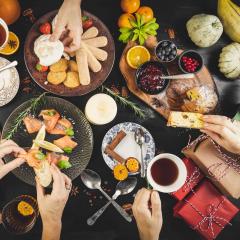From saving and scrunching your Easter egg foil (does it really work?) to becoming a waste reduction influencer, how can you recycle right and celebrate a little more sustainably this Easter weekend? We asked two UQ researchers for their tips.
Reducing waste
Like Christmas, Easter is another festive occasion where waste often proliferates and unsustainable habits creep in.
According to sustainability communication expert, Dr Franzisca Weder, from the School of Communication and Arts, these increases can be linked to common human behavioural traits.
“Behaviours tend to be based upon both intrinsic motivations and external influences,” she says.
“Easter proceeds a period that is characterised by restriction or abstinence for many people – whether for religious or health reasons (flowing on from new year’s resolutions and so on).
“But, in addition, people operate within broader social ‘norms’, which become attached to certain celebrations. For example, national days become associated with patriotic merchandise, Christmas with gift giving, children’s birthdays with party bags, Easter with excessive chocolate, and so on.”
Being aware of this can help counteract it, Dr Weder contends.
“It doesn’t have to be about giving everything up, but what are the little things you can change to reduce waste, before we think about recycling?” she asks.
“Instead of buying a dozen Easter eggs packed in a plastic carton, can you choose individual items and reduce packaging? What about quantity? Are you buying more than you need? And do you buy single-use decorations or table settings? Consider swapping these for more sustainable alternatives.”
Recycling Easter egg foil
Of course, hundreds of Easter eggs invariably means hundreds of discarded aluminium foil wrappers. Did you know these can be recycled?
In fact, aluminium is one of the most valuable metals to recycle, from an energy saving perspective, explains Associate Professor James Vaughan, Metallurgy Major Lead at the School of Chemical Engineering.
“Aluminium is the second most widely used metal in the world, but it’s also energy intensive to produce. When aluminium is recycled, there are energy savings of about 90% compared with primary production from ore. So there is definitely a big incentive to recycle,” he says.
“Also, aluminium doesn’t degrade, which means it can be used as new, as long as the recycling process separates out other metals appropriately.”
If you’re saving up your wrappers this weekend, Professor Vaughan offers this advice:
- The main thing to avoid is your recycled foil getting mixed up with paper, as paper gets recycled by breaking down the fibre structure in a sodium hydroxide solution. Aluminium metal can react with these solutions and generate hydrogen gas
- Materials are segregated at the recycling plant by their physical properties, so little loose bits of foil in among your other rubbish increases the chances of losses and cross-contamination
- Try to collect all your foil in one big ball (the South Australian Government’s Good Living website suggests a family competition!), or pop smaller pieces in an aluminium drink can before recycling.
“Metal may not be the first material that comes to mind when people think about recycling, but in fact there are many metals that are incredibly valuable and useful to recycle, and it is always worth encouraging. Usually, the logistics of collecting the material in the first place is the hard part,” he says.
Professor Vaughan leads UQ’s metallurgy major in the School of Chemical Engineering. Metallurgical Engineering offers students the chance to learn about an important part of the Australian economy, he says, which is growing alongside the demand for metals associated with the energy transition. Many students are not aware of this field when they begin their studies.
“We encourage as many engineering students as possible to take our introductory Metal Production and Recycling course, so they can get to know the field and potentially undertake further study.”
Becoming an influencer
The reality is that some of our favourite traditions will have to change, if we want to meaningfully improve sustainability outcomes, Dr Weder concludes. And this change can typically occur in one of two main ways.
“The first major driver of change is top-down regulation, similar to what we experienced during Covid. New laws are made and humans are forced to adapt.
“A second method involves individuals influencing broader behaviours. As we have noted, many celebrations involve deeply embedded norms, which are often performed unquestioningly.
“When people dare to do things differently, it creates social licence for change. So, in this case, making conscious decisions to buy less or celebrate in a way that minimises waste can help others to do the same. Especially if you talk about and share those choices.”
Dr Weder aligns this to a core area of her own research: sustainability storytelling. The field explores the use of storytelling, framing and narrative order to better understand how people perceive, interact with and communicate about sustainability and environmental issues.
“Emphasise the rituals around what you are doing. For example, if you are doing an Easter egg hunt, talk to your kids about why you do it and what they can expect to find (number of eggs or how they might share them afterwards).” Dr Weder suggests.
“Get their buy-in and agree on a new way together. In a family setting, in a workplace and in many other environments, this is a basic engagement process that works. If people agree to do things differently, you can make it a deliberate process that brings about change from the bottom up.”





